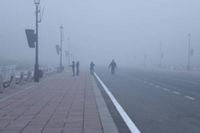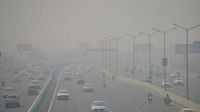As dawn broke over New Delhi on October 23, 2025, the city was once again shrouded in a thick, unyielding blanket of smog. The Central Pollution Control Board reported an air quality index (AQI) of 323 at 10 a.m., categorizing the air as 'very poor'—a label that has, for Delhiites, become all too familiar. For the fourth consecutive day, iconic landmarks like India Gate and Kartavya Path were barely visible through the haze, and commuters found themselves navigating streets with reduced visibility and a persistent sting in their lungs, according to Hindustan Times.
Photos from across the capital painted a sobering picture: metro trains slicing through a foggy veil, the ATC tower at IGI Airport barely discernible, and early morning travelers braving the toxic air. Authorities scrambled to deploy water sprinkling trucks and fogging vehicles across major neighborhoods, hoping to provide some relief. Yet, for many residents, these efforts felt like little more than firefighting in the face of a seasonal disaster that returns each year with relentless predictability.
This latest crisis is not a surprise to anyone who has followed Delhi’s annual descent into a smog chamber. On October 21, 2025, just two days prior, the city recorded a PM2.5 concentration of 442 and an AQI of 442—among the highest in the world, as reported by Policy Circle. These numbers are not just statistics; they represent a public health emergency. The World Health Organization (WHO) has labeled air pollution as the world’s largest environmental health risk, accounting for 7 million premature deaths globally each year. In Delhi, hospitals brace for surges in respiratory, cardiac, and asthma cases after every Diwali. Children and the elderly are particularly vulnerable, with the Delhi government estimating that exposure to current air levels could shorten life expectancy by nearly 12 years.
What’s behind this recurring environmental catastrophe? The causes are well-known and, frankly, maddeningly persistent. The seasonal triggers—Diwali firecrackers, post-harvest stubble burning in neighboring states, construction dust, and the winter inversion that traps pollutants—combine to create an annual toxic haze. This year, the government permitted the use of "green crackers" for just three hours on October 19 and 20, after a court-ordered relaxation. But, as Policy Circle notes, citizens largely ignored the prescribed window, with fireworks lighting up the sky late into the night, exacerbating already dire pollution levels.
Delhi’s struggle is emblematic of a broader policy collision in India: the tension between ambitious long-term climate goals and the immediate, choking reality of urban air pollution. India’s 2030 Nationally Determined Contribution (NDC) commits to reducing emissions intensity of GDP by 45 percent from 2005 levels and increasing non-fossil power capacity to 50 percent. The country’s carbon emissions are expected to peak around 2040-2045. These targets are, in theory, impressive—and yet, for Delhi’s residents, they offer little comfort when every breath brings risk. As Policy Circle observes, "the disconnect between India’s decadal climate targets and its short-term pollution crisis is widening."
Institutional fragmentation only deepens the crisis. The Commission for Air Quality Management (CAQM), state pollution boards, and urban local bodies all share responsibility, but coordination is weak and enforcement spotty. Jurisdictional confusion among Delhi, Haryana, Punjab, and Uttar Pradesh means that policies often drift from press conferences to court orders, with little continuity or accountability. Without a single empowered agency to monitor, penalize, and coordinate regional action, the city finds itself reliving the same nightmare each winter.
Delhi’s predicament is not just an environmental issue—it is a public health and social justice emergency. The city has ranked among the world’s most polluted for years, and in 2024 it held the dubious title of the worst. To meet national air-quality standards, Delhi would need to cut its annual average PM2.5 levels by a staggering 62 percent. Right now, the city’s PM2.5 concentration is 59 times above WHO’s permissible limit. The cost of inaction is staggering: according to the World Bank and the University of Chicago’s Energy Policy Institute (EPIC), India loses up to 1.4 percent of GDP annually due to health costs and productivity losses linked to polluted air. Chronic exposure reduces labor productivity, drives up healthcare spending, and even depresses learning outcomes among children. Yet, as Policy Circle points out, "these costs rarely find space in budget speeches, but they weigh heavily on India’s growth story."
Efforts to manage the crisis often take the form of short-term, reactive measures: school closures, odd-even car schemes, and bans on fireworks. While these provide fleeting relief, they don’t address the root causes. Delhi’s reliance on nearby coal power plants, lax industrial regulation, and unchecked open burning in the informal sector remain largely unchanged. The Ministry of Earth Sciences projects that air quality will stay in the “Very Poor to Poor” range for days to come, offering little hope for immediate improvement.
Experts argue that the only way forward is tighter integration between pollution control and climate action. India’s draft regulation, which sets emissions-intensity reduction targets for 282 industrial entities and introduces carbon-trading mechanisms, is a step in the right direction. It signals that air-quality management and carbon mitigation can advance together. The adoption of satellite-based emission monitoring, clean-tech buses, and the replication of Gujarat’s Emissions Trading Scheme for industrial pollutants are cited as promising avenues. Creating a real-time data network for enforcement and using price signals to discourage emissions could transform the current patchwork of reactive measures into a system of year-round governance.
Despite India’s forward-looking climate commitments, the reality in Delhi is grim. The 2045 emissions-peak timeline may reassure national planners, but for millions of citizens, the future has already arrived—in the form of coughing fits, lost school days, and lives cut short. The hazardous AQI levels of October 2025 demand immediate priority. As Policy Circle succinctly puts it, "the real question is not whether India will hit its emissions peak, but whether it can do so in a way that spares its people the toxic price of delay."
For now, Delhi’s morning smog serves as a stark reminder: ambitious climate goals mean little if they fail to clear the air for those who need it most, right now.





